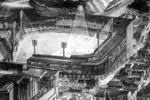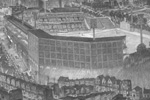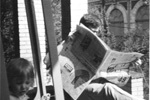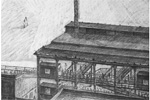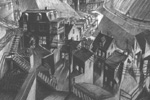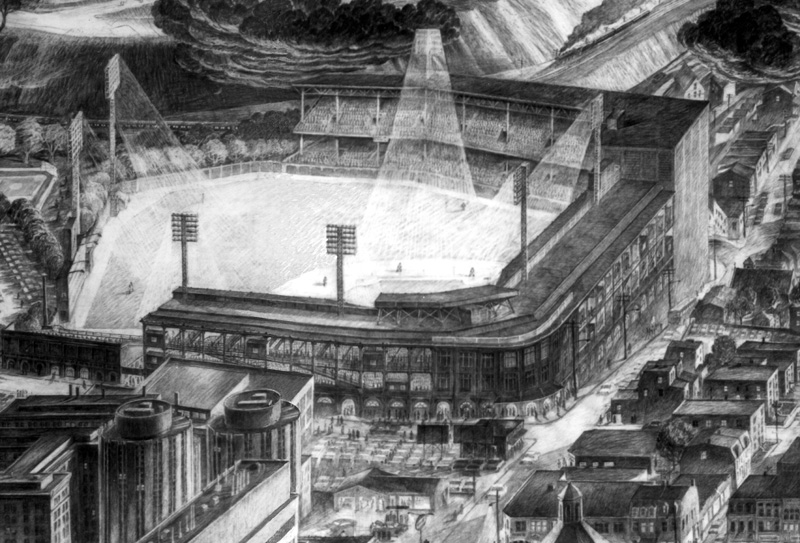
Carnegie Mellon University Center Mural (1996)

Artist: Douglas Cooper, Carnegie Mellon
Artist Assistants: Jonathan Kline + John Trivelli
Living Across from Forbes Field
(from Steel Shadows, University of Pittsburgh Press 2000)
My ex-wife Meg and I married in 1967, and soon thereafter, we moved into a first-floor duplex apartment along Bouquet Street opposite Forbes Field where we would live for three years. It was within walking distance of Carnegie Tech where I was studying architecture. That was the feature we emphasized for both sets of parents. The real reason we moved there was baseball.
Our apartment was up a steep slope from Bouquet Street and was reached by a long climb of steps. From our front porch we had a good overview of the street and, more importantly, the players' entrance directly across from us. We were close enough to the grandstand that fans taking a break between innings along the outside rail could call down to us if we were sitting on our porch. Our neighbors in the second floor apartment were high enough to see over the lower grandstand and into the field where they had a good view of second base.
Downstairs we had to be content with a somewhat confused sense of the events of Forbes Field based on sound alone. A Saturday afternoon promotion, which would fill the nearby right field stands with several thousand cub scouts cheering every wiggle and waggle, would distort our impression of the game's progress. That first summer Meg and I woke up one Saturday morning (our bedroom faced away from the field ) startled by lions roaring and elephants trumpeting off in the distance. The previous evening the Police Circus had moved in and the outfield was now a parking lot of caged beasts.
Bouquet Street was fast becoming a student ghetto, but it still had the flavor of the first generation Italian neighborhood it had once been. At the end of Bouquet Street, down the city steps below Dawson where Meg and I often took evening walks, we still heard Italian. Our neighbors on one side were from L'Aquila near Rome. The grown sons Mario and Chi-Chi still lived at home-one ran the bar up the street-and the parents spoke little English. We spoke to the sons and gestured to the parents, porch to porch.
On the other side was the First Spiritualist Church, which conducted regular seances and often gathered in a weed overgrown back yard to await contacts. The only effect the spiritualists might have had on our lives was the size of the vegetables we grew in our otherwise unfertile backyard. One carrot we pulled from the garden that first summer measured three inches in diameter. We cooked it nevertheless. It had the consistency of wood and might have been used to kill vampires. Most of that first summer we spent painting the house and building furniture. We had much to prepare for because Meg was pregnant. Just before Christmas that first year, our daughter Laura was born.
Winter across from Forbes Field brought an increase in the rat population. These were fearless rats grown huge on a summer of ball park peanuts and Cracker-Jacks. Several times I descended to the basement in knee-high boots, armed with a tennis racket to do battle with them as they hissed at me from atop the central beam. And there were other pests. Our first upstairs neighbors were Korean. We had no contact with them except for the smell of cooking oil from their back porch where they kept a wok. On Korean New Year they got drunk, fell down the stairs, and the next day moved out. On the day after that, the roaches moved out of their apartment and into every available space in ours, even our refrigerator.
However, when I think of this apartment, I think most of all of the summer evenings on the porch opposite Forbes Field. We had two rocking chairs, a round table for mugs of beer, and a radio for Bob Prince and Jim Woods to keep us up with the game. There was a band of young kids who used to gather in the street at the base of our steps waiting for foul balls to come over the roof. Bob Prince would alert them by radio if one were coming. It was important for them to know who had hit the ball because one from a star player like Willie Mays or Roberto Clemente would fetch a higher price. Usually these balls would land on the tarmac or on a car roof and with high arching bounces would lead the band of boys on a chase down Bouquet Street or sometimes all the way to the base of the hill down Joncaire.
Once and only once did a ball land on our porch. I was alone in my rocker, drinking a beer and listening to Bob Prince, so I had advance warning. I looked up as the ball flew out of the glow of the light stands overhead and landed right beside me where it rattled back and forth between the house and the brick parapet wall. I took my time. I considered it mine already, a gift from God and much welcomed because, in all the games I had attended, I had never once caught a major league ball. I put my beer down and went over to the ball, which was now rolling towards the steps. Just as I leaned over to pick it up, a hand from one of the street boys hooked around the parapet and grabbed the ball away.
The radio alerted us when the game had reached the seventh inning stretch and the Pirates had opened the bleacher gate so fans could exit easily. If the game was still close, we would gather up Laura from her bed, put her into a basket where she would continue to sleep soundly, and head over to the bleachers for the several innings that remained. The left field bleachers were a wonderful place to view a game. They were close to the action because they paralleled the third base line. It was on one of these free visits to Forbes Field that we witnessed the "throw." Usually when I think of Roberto Clemente, I think of the cat-like tension and precision with which he prepared to face the pitcher. But if there is a single play I remember, it is his one errant throw. It was the only error I ever saw him make. Someone hit a long line-drive deep into right center field. Clemente caught up with it on perhaps the third bounce at the 436 ft. sign near the outfield exit gate, and in one motion he whirled and threw toward third base. Clemente threw almost straight-armed, as if throwing a javelin. His throw started out on a low line, but then it started to rise. And it kept on rising: over the third baseman's head, over the coach's head, over the dugout, and far up into the stands, still rising and rising with an energy internal. The runner trotted home. No one clapped. No one booed. There was no response. No one had known a throw could travel that far.
There were also interesting bleacher regulars. There was the man who ran the scoreboard. On hot days inside that green metal oven, he was often visible, stripped down to his underwear, through the opening of an as yet unrecorded inning. There was a bald man and his wife who ran the food concession. It was an informal concession, just a terrace cooker for hot dogs and several stacked cases of Coca-Cola. When we would take Laura to night games, she would occasionally wake up, and her outstretched arm or foot would startle the bald man who had assumed our basket on the bench was a picnic dinner.
From my rocker on the porch, there was a sequence to each baseball game only part of which concerned the actual play. The smell of popcorn and peanuts was the first sense. Then the players began arriving. Most of them parked in a lot under the right-field stands and walked up the long slope to the players' entrance across from us. During the three years we lived on Bouquet Street, 1967-70, "the walk of the arriving players" changed quite a bit. It was during this interval and after the assassination of Martin Luther King that the black players began to dress more assertively. By 1970 "the walk" had the feel of a fashion runway. Doc Ellis, who would later become infamous for pitching a no-hitter while on LSD, got the most commentary from the porch sitters up the slope for his pink suits. Willie Stargell had some great white ones. Roberto Clemente remained a more classic dresser.
About three hours before game time, the hot dog stands opposite the main-gate would open. If I stood up, I could see their open awnings from my porch. Then came a gathering crowd, a hush, the national anthem, the booming voice of Art McKennan announcing each batter, and the game itself. A few minutes after the game, a bus would pull up outside the players' entrance and wait for half-an-hour to pick up the visiting team for the trip back to the hotel. The engine was kept running to keep the air-conditioning up, and a crowd would gather. Sometimes I would go across the street myself to wait for a close-up of the visiting players and their groupies under the heat-wash of the air-conditioner's exhaust. The park didn't close down totally until well into the night when the clean-up crew was done sweeping away the peanut shells and crushed cups.
Occasionally there was a turnabout in our role as observers. Long rain delays brought bored fans to the back edge of the stands where they looked back at us. The rickshaw-like porch-swing that I made for Laura and painted electric pink got a lot of comments. Meg, while pregnant with Laura, was once called, "beer-belly." But most of the comments were directed at our upstairs neighbor who had a huge tangle of hair, built a quasi-religious shrine with candles on his porch, and was for these fans the very anti-Christ.
-Douglas Cooper. 2000
